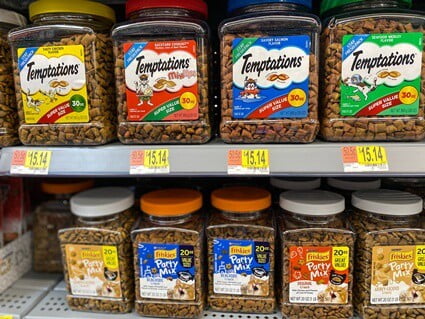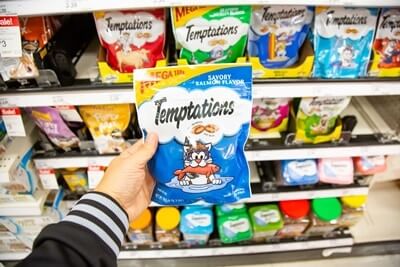Temptations are one of the best-known cat treats. Cats can’t get enough of them and reject their everyday food in favor of a few crunchy treats. But too many can cause addiction, weight gain, and nutritional deficiencies. That’s why you must restrict the amount you feed.
Cats love eating Temptations because they come in a range of meaty and seafood-inspired flavors. They’re made with animal digest, which is an ingredient commonly found in pet food. It’s made from undecomposed animal protein and gives Temptations a scrumptious flavor that cats can’t resist. While the treats are made from natural ingredients, they contain additives and flavorings, causing some cats to become addicted.
Only feed your cat the recommended amount of 15 treats a day. If you give your cat too many, it may develop behavioral problems, such as aggression and begging. If this happens, you’ll need to wean your cat off the treats.
Can Cats Become Addicted to Temptations?
Many cats love the taste of Temptations treats – so much so, they can’t get enough of them. If you’re wondering why cats are addicted to Temptations, the main reason is that they contain a double basting of digest, which is what is in temptations that cats love.
Animal digest is a common ingredient in pet food and treats produced by the chemical or enzymatic hydrolysis of undecomposed animal protein, including liver, muscle, and soft tissues.
This process breaks down the protein into short strings of amino acids, which are the building blocks of protein, giving Temptations a tasty flavor. According to the scientific journal Animals, cats are innately drawn to foods with a strong umami flavor produced by a high concentration of amino acids. That’s what makes animal digest so palatable for cats. Signs of cat treat addiction include:
- Whining and meowing
- Pawing at the spot you store the treats
- Agitation and irritability
- Pacing up and down
Temptations are also available in several tempting flavors, including:
- Tuna
- Salmon
- Shrimp
- Catnip
- Chicken
- Turkey
- Beef
- Lobster
- Creamy dairy
- Crab
This wide range of flavors means there’s something for all cats to enjoy, even the fussy ones. Unfortunately, because Temptations are so tasty, some cats beg for them and even refuse to eat their regular food.
If you indulge your cat in a handful of Temptations every day, you’re fuelling this addiction. Cats that are addicted to Temptations meow, hiss, and scratch to get hold of them.
They also scratch at the cupboard they know their treats are stored to get hold of them. This behavior will only get worse if you don’t put a stop to it.
Are Temptations Treats Safe for Cats?
There are no specific health benefits of Temptations treats. Because you can only feed your cat a limited amount each day, you shouldn’t encounter any problems, making them safe to eat. Problems arise when you give your cat too many.
Now you know they’re safe, you’re likely wondering, are Temptations healthy for cats? While you must feed your cat these treats in moderation, they are beneficial for the following reasons:
Positive Reinforcement
Temptations are an excellent reward for positive reinforcement, which is a training technique used for various things. You can use positive reinforcement to encourage cats to learn tricks or improve their behavior, which treats are a significant part of.
Because cats enjoy Temptations so much, they’re more likely to obey you to get hold of a tasty biscuit or two. Feeding one at a time minimizes the risk of over-feeding, meaning they’re not a health risk.
Improve Mood
If your cat feels sad or depressed, feeding it a couple of Temptations can improve its mood and make it feel better. You can increase these positive feelings by putting a few Temptations into a treat-dispensing toy to distract your cat and enhance its wellbeing. Cats are hard-wired to hunt, which these types of toys replicate.
Build Bonds
Feeding your cat Temptations is a great way to build your bond. Cats that enjoy these tasty treats will form positive associations, as they recognize that you’re responsible for providing them. If you have a scared, nervous, or anxious cat, offering Temptations can help bring the animal out of its shell. It’ll also help you gain its trust.
Fussiness
If you have a fussy cat who doesn’t like its food, feeding it Temptations encourages it to eat something, preventing it from going hungry. While the treats are junk food for cats, they’re made from natural ingredients, so they’re better than nothing and far healthier than cats going hungry.
Are Temptations Bad for Cats?
Unfortunately, Temptations haven’t always had good press. In the past, it was claimed that 12 cats were poisoned after eating the treats, with two of them going on to develop renal failure. While there have been no vet-reported cases, it’s only natural for owners to be concerned.
The good news is Temptations are safe in moderation. However, you must pay attention to the following ingredients and potential health issues before feeding them to your cat:
Nutritional Deficiencies
If you allow your cat to fill up on Temptations, it’ll miss out on the vitamins, minerals, and nutrients it needs from its balanced, everyday food.
According to VCA Hospitals, nutritional deficiencies occur when cats are fed poor quality commercial dry food. They can also develop if their commercial diets are supplemented incorrectly.
Always count how many Temptations you feed your cat at one time, and don’t exceed the recommended daily dose. If you do, you risk your cat developing deficiencies.
Grain Products
Temptations contain grain products, which cats don’t eat as part of their natural diet. It’s thought that this is because it protects them from eating poisonous plants. A small percentage of cats are sensitive to grains, so Temptations aren’t suitable for every cat.
However, grains are a good source of fiber, minerals, vitamins, essential fatty acids, and digestible proteins. That’s why Temptations are fine in moderation – you mustn’t feed them to your cat.

Corn Gluten
Some Temptation varieties contain corn gluten, which is added as a low-cost protein source. However, it has little nutritional value, as it contains no amino acids, serving as a filler ingredient.
In the worst cases, prolonged consumption of corn gluten can cause your cat to develop severe allergies to the ingredient over time, resulting in GI and skin problems.
Added Flavorings
Temptations treats contain several added flavorings, including salt and colorings. While they’re natural ingredients, they’re not foods cats usually eat, potentially causing health issues and tummy issues.
Similarly, these kinds of ingredients are addictive, which is part of the reason why cats enjoy Temptations so much. Not only can they be bad for their physical health, but they can affect cats mentally, causing behavioral issues.
These ingredients make Temptations the equivalent of junk food in the cat world.
Weight Gain
Each treat is under two calories. While this isn’t a lot, the average indoor cat only needs 20 calories per pound to maintain its weight. Outdoor cats need slightly more calories, at 35 per pound of body weight.
If you feed your cat Temptations treats too often, you risk causing it to gain weight. It’s difficult to contextualize the number of calories cats need compared to our own nutritional requirements. But as they’re much smaller animals, many owners are surprised by how few calories they consume. Health conditions caused by excessive weight include:
- Arthritis
- Difficulty moving
- Heart, kidney, and liver problems
- Diabetes
- Cystitis
For context, wild cats eat between 6-9 small mice a day, which provides them with the nutrients they need.
Diarrhea
Temptations can cause diarrhea. This is either because you’ve fed your cat too many over a prolonged period, or you’ve recently introduced the treats into your cat’s diet and its body’s getting used to them.
Once your cat gets used to them, its diarrhea should stop. However, diarrhea is never a good sign. If your cat develops tummy troubles after eating Temptations, you must cut down on the amount you feed and abstain for a few days until your cat recovers.
Allergies
Cats that are sensitive to certain ingredients in Temptations may suffer from an allergic reaction after eating them. In many cases, owners don’t know their cats have an allergy until after consuming the food that triggers the reaction. Symptoms of a Temptations allergy in cats include:
- Itchy skin
- Hair loss
- Diarrhea
- Flatulence
- Vomiting
- Abdominal pain
- Listlessness
- Scratching
- Pustule looking bumps on the skin
According to The Journal of Nutrition, food sensitivities most commonly manifest as dermatologic. The most common allergens are chicken, beef, and fish – the core flavors of the Temptations range.
While it’s relatively uncommon for cats to suffer from an allergic reaction after eating the treats, it can happen. Keep an eye on your cat for any clinical signs.
What Do Temptations Do to Cats?
A common question owners have is, do cat treats make cats hyper? Unfortunately, the answer’s not a simple one. Not all cats become hyper after eating Temptations – most accept the tasty treat before going about their business.
However, some cats have an adverse reaction to cat treats and suddenly become hyper. One possible reason for this is over-excitement about the thought of their favorite foods.
Some cats are highly food motivated and spend the majority of their days trying to get treats. This most commonly occurs in cats that have developed an addiction to cat treats. Over-excitement and hyperactivity caused by cat treats are tell-tale signs you’re feeding your pet too many treats.
Another reason cat treats make cats hyper is that they provide a burst of energy, giving cats fuel to play. Hyperactivity looks like this:
- Zoomies, where cats run around the house
- Jumping between furniture
- Climbing
- Chasing humans and pets
- Compulsive licking and grooming
- Meowing
- Batting with paws
This is entirely normal, as long as you haven’t given your cat too many treats.
Can Cats Eat Temptations as a Meal?
Most Temptations treats are 100% complete and balanced, providing all the nutrients your cat needs. However, they’re not a substitution for your cat’s regular food and should be provided alongside a well-balanced meal.
You should only feed up to 15 treats per 10 lbs (4.5 kg) of Temptations every day. You can feed them at the same time or sporadically throughout the day, but don’t exceed the recommended amount.
According to the manufacturers, you can replace ¼ cup of Whiskas Meaty Selections with ¼ cup of Temptations treats, as long as you provide fresh drinking water at all times. If you choose to do this, you might want to consider mixing the treats with your pet’s canned wet food to improve the texture and consistency.
If you’re feeding your cat Temptations to eliminate hairballs, you can provide your pet 10 treats per day at the same time until symptoms disappear. To prevent hairballs from occurring, feed 10 treats per cat every other day.
Applying portion control methods is the most effective way to ensure your cat doesn’t overeat Temptations treats.
How To Wean a Cat off Temptations
There are instances when cats become too addicted to Temptations and need help breaking the habit. Other times, cats become poorly after eating them and need to switch to more suitable treats.
Unfortunately, if you appease your pet with treats to quieten it down and stop the poor behaviors, it’ll become trapped in a vicious cycle.
Cat treat addiction isn’t easy to break, but it’s possible with some time and patience. To wean your cat off temptations, you must be firm. Don’t give in to your cat’s demands, even if it bites and scratches for treats. If you do, you’ll have to start the process again.
Automatic Feeder
Cats behave poorly for treats because they understand their owners are responsible for feeding them. If you’re bonded, your pet will use this against you. Using an automatic feeder removes you from the equation, discouraging your cat from bothering you for treats.
High-quality feeders can be programmed to provide treats at various times of the day, creating a strict routine your pet will have to get used to if it wants a treat. This naturally helps you limit the amount you feed your cat, too.
Another option is a treat-dispensing toy. Making your cat work for its treats will make it realize that tasty food doesn’t come easily – your pet will need to work for them.

Change the Treats
If Temptations are the problem, try swapping them out for a less tasty treat brand to curb your cat’s enthusiasm for junk food.
Another thing you could try is replacing the Temptations with a healthier treat food, such as cooked chicken or tuna, offering them in small portions. That way, your cat will consume the protein and amino acids it needs without the unnecessary added ingredients.
Playtime and Exercise
Distract your cat from treats with playtime and exercise. Some cats demand treats because they’re bored. To prevent this, spend a significant amount of time playing with your cat’s favorite toys and games and provide it with as much physical and mental stimulation as possible.
Not only will this combat your cat’s Temptation addiction, but it’ll help keep its weight at a healthy level. This is important if your cat’s put on weight because of too many treats.
Clicker Training
Reverting to clicker training gives your cat the chance to work for a treat instead of expecting some whenever it demands. It almost becomes a prize or reward, making your cat feel less dependent on having them at all hours of the day.
Ration Treats
The most effective way to wean your cat off treats is to ration them as much as possible. This is a painful process as your cat will almost certainly demand them. You could also try restricting them entirely for quicker results.
If you give your cat treats every time it asks, this option is a good one to use at the same time as playing with your pet. Eventually, your cat will forget about the treats, breaking the addiction.
While it’s not safe to give your cat too many Temptations treats, the recommended daily amount is safe. Be careful not to overfeed your cat and monitor it to ensure it doesn’t develop any significant behavioral problems. If it does develop problems or show signs of addiction, you’ll need to wean your cat off the treats.
Images: The Image Party / Shutterstock.com


hi richard
well you confirmed my suspicions! my cat is definitely addicted to temptations treats! i fear he may have to go to vet for detox! im going to try the suggestions for withdrawal you write here. who knew? and its all my grandsons fault. im kidding. but i did allow my grandson to give him treats whenever and as often as he liked as it was the only way my cat would allow the toddler who adored the cat to get near him and i created the addiction by giving in to my cats demands after my grandson went home! my gosh. i am happy to have found your article as i love my beastieboy ( the cat ) and want him to be healthyb and happy. i want that for my grandson as well i mean oh dear. my cat is a temptation addict. ok. knowledge is power thank you. mama b.
Great article! As a professional Certified Pet Sitter, and mom of 4 rescue cats, I often give my cats Temptations. However, my new kittens who are under one, have constantly been dealing with loose stools and a weight gain. Taking away their treats, albeit sad, has helped keeping their # 2 better. I plan to share this with my pet parents, thank you! Michelle, a Crazy Cat Lady
Same as the above. My goodness… I suddenly feared an addiction was occurring. Weight gain and refusal to eat anything else. Complicated history of this dear girl. Will wean off and continue with good moggy food. What a trap🙈
Our cat is addicted to Temptations. He had to go to the vet today and have 8 teeth pulled. So, I can’t try and wean him off of them. Seems it will have to be cold turkey and that worries me. I put the treats up so he doesn’t have to see them. He keeps coming to me and going to the table, trying to have me give him some. Would I be able to crush some into a powder and add to his wet food? He is 13 years old.
So I am a little late to this conversation but find it very amusing. Are our cats becoming addicted to Temptations or are we becoming addicted to the affection or attention our furry feline friends show us when we give temptations to them?? I have rescued all of my cats, and they are always older because everyone loves kittens, but the older ones need love too. You don’t know what the older ones have gone through, so you try to gain their trust by using treats. I know one of mine was a feral and she is very skittish. One was much older and didn’t eat anything but her cat food and now I have one without teeth and loves treats but also love on us after we give him treats. LOL just another take on things or maybe just a different look at things.